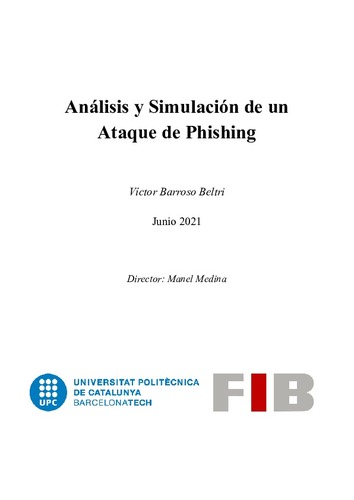Mostra el registre d'ítem simple
Análisis y Simulación de un Ataque de Phishing
| dc.contributor | Medina Llinàs, Manel |
| dc.contributor.author | Barroso Beltri, Victor |
| dc.contributor.other | Universitat Politècnica de Catalunya. Departament d'Arquitectura de Computadors |
| dc.date.accessioned | 2021-11-08T15:35:59Z |
| dc.date.available | 2021-11-08T15:35:59Z |
| dc.date.issued | 2021-06-28 |
| dc.identifier.uri | http://hdl.handle.net/2117/355777 |
| dc.description.abstract | El principal objetivo de esta tesis es el análisis de un ataque de Phishing, explicando en detalle el funcionamiento de estos, los distintos tipos que podemos encontrar, de qué vulnerabilidades se aprovechan, como ha evolucionado a lo largo del tiempo y cuáles son los datos más recientes relacionados con el tema. Posteriormente, se utilizará el framework GoPhish para realizar una simulación de un ataque lo más real posible imitando dos webs distintas. Para comprobar la consciencia de la gente sobre este tipo de ataque se realizará un cuestionario y se estudiarán los resultados. Por otro lado, se investigarán los filtros de Spam, los cuales a día de hoy son la principal defensa contra ataques de Phishing, y se utilizará Jupyter Notebook para generar un modelo de Machine Learning que cumpla la función de un filtro sencillo. Por último, se darán una serie de recomendaciones que pueden servir al lector para mejorar la seguridad de sus datos e intentar evitar caer en un ataque de este tipo. |
| dc.description.abstract | The main objective of this thesis is the analysis of a Phishing attack, explaining in detail how these attacks work, the different types that we can find, what vulnerabilities are exploited, how it has evolved over time and what are the most recent data related to the topic. Later, the GoPhish framework will be used to simulate an attack as real as possible, imitating two different websites. To check people's awareness of this type of attack, a questionnaire will be carried out and the results will be studied. On the other hand, Spam filters will be investigated, which today are the main defense against Phishing attacks, and Jupyter Notebook will be used to generate a Machine Learning model that fulfills the function of a simple filter. Finally, a series of recommendations will be given that can serve the reader to improve the security of their data and try to avoid falling into an attack of this type. |
| dc.language.iso | spa |
| dc.publisher | Universitat Politècnica de Catalunya |
| dc.subject | Àrees temàtiques de la UPC::Informàtica::Seguretat informàtica |
| dc.subject.lcsh | Computer security |
| dc.subject.other | Seguretat |
| dc.subject.other | Spam |
| dc.subject.other | Phishing |
| dc.subject.other | GoPhish |
| dc.subject.other | cibercrim |
| dc.subject.other | correu |
| dc.subject.other | Gmail |
| dc.subject.other | filtre |
| dc.subject.other | ciberseguretat |
| dc.subject.other | concienciació |
| dc.subject.other | enginyeria social |
| dc.subject.other | malware |
| dc.subject.other | Security |
| dc.subject.other | Spam |
| dc.subject.other | Phishing |
| dc.subject.other | GoPhish |
| dc.subject.other | cybercrime |
| dc.subject.other | |
| dc.subject.other | Gmail |
| dc.subject.other | filter |
| dc.subject.other | cybersecurity |
| dc.subject.other | awareness |
| dc.subject.other | Information Technology Social Engineering |
| dc.subject.other | malware |
| dc.title | Análisis y Simulación de un Ataque de Phishing |
| dc.type | Bachelor thesis |
| dc.subject.lemac | Seguretat informàtica |
| dc.subject.lemac | ciberseguretat |
| dc.identifier.slug | 161449 |
| dc.rights.access | Open Access |
| dc.date.updated | 2021-07-05T04:02:20Z |
| dc.audience.educationlevel | Grau |
| dc.audience.mediator | Facultat d'Informàtica de Barcelona |
| dc.audience.degree | GRAU EN ENGINYERIA INFORMÀTICA (Pla 2010) |


